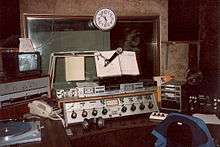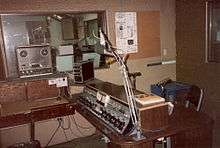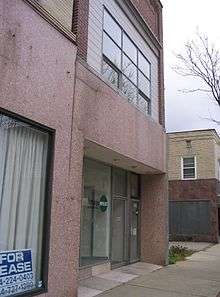WMNY
WMNY is a South Asian radio station airing as 'Radio Dhoom' serving the Greater Pittsburgh, Pennsylvania market. The station, which is owned by Gagan Deep, through licensee Radio 1150 Limited Liability Company, broadcasts at 1150 kHz with a power level of 1,000 watts daytime and 70 watts night, and using a two-tower directional antenna system. WMNY is licensed to New Kensington, Pennsylvania.
| Broadcast area | New Kensington, Pennsylvania / Pittsburgh |
|---|---|
| Frequency | 1150 kHz |
| Branding | "Radio Dhoom" |
| Slogan | "Radio Dhoom USA" |
| Programming | |
| Format | South Asian |
| Ownership | |
| Owner | Bhavna Gupta (Radio 1150 Limited Liability Company) |
| History | |
| First air date | October 1940 (as WKPA) |
| Former call signs | WKPA (1940-1993) WGBN (1993-2014) |
| Technical information | |
| Class | D |
| Power | 1,000 watts (directional daytime) 70 watts (directional night) |
History
The station was once a Top 40 outlet, WKPA, and was a sister station to WYDD.
The construction permit for WKPA was granted on June 25, 1940. The station was initially licensed to operate at the federally assigned frequency of 1120 kHz, with a power output of 250 watts daytime only. The station was granted permission to operate from October 3 to October 8 with extended hours to 10pm for dedicatory program reasons. The FCC also granted permission for WKPA to remain on the air until 3am from November 5 to 6 for election return reports.
WKPA operated at this frequency until the NARBA frequency re-allocation act was adopted in 1941. That year, WKPA moved to its present dial position but continued to operate at its daytime-only status.
WKPA was a typical, small-town radio station of its day. Local news, sports, and talk from the steel town of New Kensington, Pennsylvania, 20 miles northeast of downtown Pittsburgh. The station began at 810 Fifth Avenue, New Kensington, on the second floor of a two-story building that also housed a music store on the ground floor. Cooper Brothers, the owners of the music store, operated WKPA under the corporate name of Allegheny-Kiski Broadcasting Company, with Edward Kroen serving as the station's general manager and program director.
In 1957, Allegheny-Kiski Broadcasting Company applied for a construction permit to increase WKPA's power to its current level of one thousand watts, daytime only, which required the construction of a second antenna at its transmitter site in East Deer Township. Concurrently, the company applied for permission to add a second studio location at 321 Fifth Avenue in Tarentum. This second studio stayed in operation until 1963.
The Cooper family sold the station on July 2, 1964 to Pittsburgh entrepreneur Nelson L. Goldberg, who by then worked for the Cooper family as WKPA's general manager. Goldberg operated the station until its 1990 sale as Gateway Broadcasting Enterprises, Inc., not to be confused with Gateway Communications, which at that time owned a television station in Altoona, though both companies had roots in television.



WKPA: the birthplace of modern cable TV
Goldberg, an innovator, pioneer and visionary in the telecommunications industry, developed the first cable system to be acquired by Comcast. The son of the late Edward and Fannie Menzer Goldberg, was a native of New Kensington, Pennsylvania.
Goldberg’s career began in radio sales at WKPA in New Kensington. In 1958, at the age of 28, Goldberg became General Manager of WKPA and then purchased the station in 1964. Goldberg acquired WYDD-FM in 1963 and operated the radio stations for more than 25 years. Goldberg developed WEFB-TV (TV3) and Westmoreland Cable in 1968, one of the first cable franchises in western Pennsylvania. The cable system was later sold to Comcast Corporation.
In the 1980s, Goldberg was the first to privately own satellite transponders and perceptively anticipated the advent of commercial television satellite broadcasting. Throughout his career, he continuously broke ground in developing new kinds of broadcast programming and the manner in which they were transmitted. As his company's reputation grew, so did that of WKPA.

The sale of WKPA
Both stations were sold to California-based Salem Communications Corporation in the late '80s; the transaction was not completed until early 1990. When Salem assumed ownership, WKPA and WYDD (which by this time had become known as Top 40 rocker WNRJ) immediately underwent changes: WYDD switched from Top 40 to an easy listening format and the subsequent call letter change to WEZE-FM, with WKPA simulcasting WEZE's programming Monday through Friday, with existing weekend oldies and ethnic programming as its only original programming. WEZE-FM moved its studios to suburban Pittsburgh in the spring of 1991, leaving WKPA at its Fifth Avenue location, but continuing the simulcast. Later that year, Salem officials announced that WEZE-FM would drop its easy listening format for Christian Talk, the benchmark format for the other corporate-owned stations. As part of the change, WKPA would have to originate its own programming as part of the contract deals Salem had with its client ministries. Salem appointed a former WEZE-FM announcer, Ken Hawk (who at 21 became one of the youngest radio executives in commercial radio history. Brian Mroziak at nearby WMBS was later another) to manage WKPA's operations. Under Hawk's direction, WKPA brought back a live adult contemporary morning show with local news and talk, plus a nationally syndicated talk format for weekday programming. The oldies and ethnic programming remained untouched. The rebirth of WKPA was successful but short-lived, with Salem spinning off WKPA to Pentecostal Temple Development Corporation in November 1992
Born again: WGBN Gospel 1150
Salem donated WKPA to PTDC as a gift to the East Liberty-based church headed by pastor Rev Dr. Loran Mann, who changed the format to Black Gospel and the station's call letters to WGBN. The station made history as the first full-time gospel-formatted station in the Pittsburgh market (others followed with little success) and remains so today. Programming is made up of sermons from Pentecostal Temple, and music is provided by Musical Soul Food Network's "Rejoice!" format. WGBN's current studio location since 1995 is at 560 7th Street in New Kensington. The radio station occupies the ground and second floor of half of this building.
WGBN swapped call signs on March 1, 2014 with sister station WMNY AM 1360.
Effective January 3, 2018, Pentecostal Temple Development sold WMNY to Radio 1150 Limited Liability Company.
Changes
WMNY today broadcasts from studios on Seventh Street in downtown New Kensington. The station was forced to abandon its original location at the Cooper Brothers building after the roof over its studios collapsed in 1994. The station then moved one block over to 955 Fourth Avenue, where it occupied the second floor, but the station would only be there for a year.
In 1995, a fire gutted out both WGBN and the computer business that occupied the ground floor of the building both were housed in. Though WGBN's losses were covered by insurance, it would be more than six months until the station was able to return to the air from its new location at 560 Seventh Street, where it remains today.
Famous voices
Among the talent that has roamed in and out of WKPA through the years includes Bob Livorio, Jeff Allen, Charlie Apple, Alex Mellon, Porky Chedwick, Sean Israel, Joe Fenn, Jim DeCesare, Ford Shankle, Kelly Pidgeon, Mike Alexander and George Hart.
References
External links
- WMNY in the FCC's AM station database
- WMNY on Radio-Locator
- WMNY in Nielsen Audio's AM station database